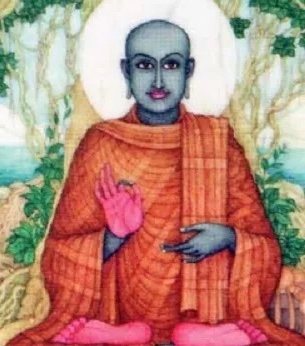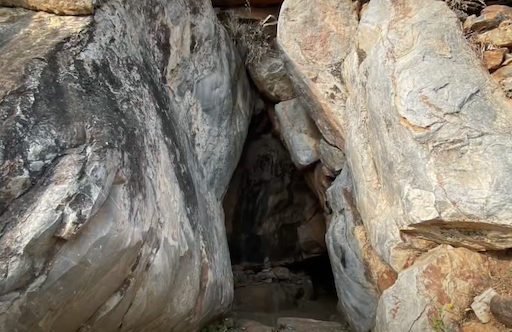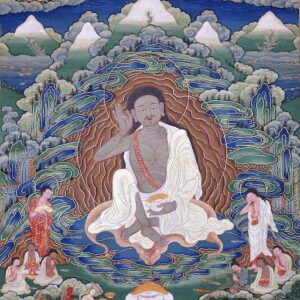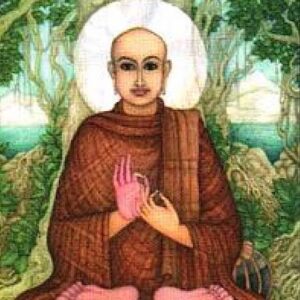This is Mogallana’s sadhana cave in an ancient site where Buddha gave sermon to the monks. There is a place to sit and meditate. You can go into meditative states here effortlessly.
How to Get there
From Rajgir, you can take a horse tonga to the base of Gridhakuta hill, then take maximum 30 mins hike to the hill. This is the third cave on the left of the stairs leading to the top of Vulture Cave.
Map: https://goo.gl/maps/XFFPAJNGSfF7xJhdA
About Mogallana
Maudgalyāyana (Pali: Moggallāna), also known as Mahāmaudgalyāyana or by his birth name Kolita, was one of the Buddha‘s closest disciples. Described as a contemporary of disciples such as Subhuti, Śāriputra (Pali: Sāriputta), and Mahākāśyapa (Pali: Mahākassapa), he is considered the second of the Buddha’s two foremost male disciples, together with Śāriputra. Traditional accounts relate that Maudgalyāyana and Śāriputra become spiritual wanderers in their youth. After having searched for spiritual truth for a while, they come into contact with the Buddhist teaching through verses that have become widely known in the Buddhist world. Eventually they meet the Buddha himself and ordain as monks under him. Maudgalyāyana attains enlightenment shortly after that.
Maudgalyayana and Śāriputra have a deep spiritual friendship. They are depicted in Buddhist art as the two disciples that accompany the Buddha, and they have complementing roles as teachers. As a teacher, Maudgalyayana is known for his psychic powers, and he is often depicted using these in his teaching methods. In many early Buddhist canons, Maudgalyāyana is instrumental in re-uniting the monastic community after Devadatta causes a schism. Furthermore, Maudgalyāyana is connected with accounts about the making of the first Buddha image. Maudgalyāyana dies at the age of eighty-four, killed through the efforts of a rival sect. This violent death is described in Buddhist scriptures as a result of Maudgalyāyana’s karma of having killed his own parents in a previous life.
Through post-canonical texts, Maudgalyāyana became known for his filial piety through a popular account of him transferring his merits to his mother. This led to a tradition in many Buddhist countries known as the ghost festival, during which people dedicate their merits to their ancestors. Maudgalyāyana has also traditionally been associated with meditation and sometimes Abhidharma texts, as well as the Dharmaguptaka school. In the nineteenth century, relics were found attributed to him, which have been widely venerated. His female counterpart was Utpalavarṇā (Pali: Uppalavaṇṇā).
About Gautam Buddha’s Vulture Peak, Gridhakuta Hill
This is one of the most ancient sites where the Buddha is said to have preached his Lotus Sermon. Quite true to the meaning of its name as Vulture Peak indeed the peak appears as a shape of vulture head with a natural stone formation. The place is also referred as “Gujjhakut” in Buddhist text. One of the most ancient sites where the Buddha is said to have preached his Lotus Sermon was amongst the favorite meditating place of the Buddha. Even today one can feel the deep sense of spiritual power at the peak that is devoid of any man-made grandeur. A statue of the Buddha (600 BCE) was found here and currently housed at Archeological Museum of Nalanda.
During the Buddha’s time Rajgir, then known as Rajagaha, was the capital of Magadha and the largest city in north India. Spread out over a fairly wide area you will find the cool and shady Bamboo Grove, Devadatta’s Cave at Makdum Kund, the Sattapanna Cave where the First Council was held, Jivaka’s Mango Grove, Ajatasattu’s stupa, the Pipphili Cave where Maha Kassapa liked to stay and the Boar’s Grotto where Sariputta was enlightened, to name but a few.
Source
https://bodhi.travel/blog/rajgir-and-vulture-peak
https://www.buddhanet.net/e-learning/pilgrim/pg_23.htm
https://en.wikipedia.org/wiki/Maudgalyayana





